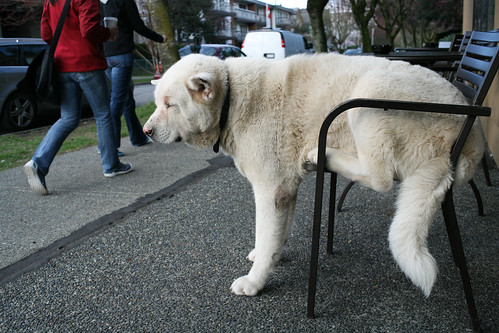
Inappropriate urination, now termed “periura” by veterinary professionals, is one of the most frustrating and disgusting problems cat owners may face with their indoor cat. For varied reasons, cats may turn to a different substrate on which to urinate, leaving that litter box untouched for a more preferable place to relieve themselves. Many times it is on your bed, in the bathtub, a spot behind the couch, or for the really special cat, right on the floor in front of you. What do these spots have in common, you may ask? They are likely cleaner, quieter, better smelling places to do business than the litter box. Perhaps an aggressor cat is preventing a more subservient cat from using the litter box, or those stray cats you feed are upsetting your indoor cat. Whatever the reason, it can be difficult to correct.
 Before initiating any of the suggestions or hints below, please take your cat to see the veterinarian. There may be an underlying medical problem causing the cat to drink more water or urinate more frequently, such as diabetes; hyperthyroidism; osteoarthritis; kidney disease or infection; bladder infection, bladder stones or crystals; tumor or Feline Lower Urinary Tract Disorder. Allow your veterinarian to do diagnostics such as blood work, urinalysis, urine culture and x-rays. All of these in combination can form a complete picture of health for your cat and help discern a medical problem from a behavioral problem.
Before initiating any of the suggestions or hints below, please take your cat to see the veterinarian. There may be an underlying medical problem causing the cat to drink more water or urinate more frequently, such as diabetes; hyperthyroidism; osteoarthritis; kidney disease or infection; bladder infection, bladder stones or crystals; tumor or Feline Lower Urinary Tract Disorder. Allow your veterinarian to do diagnostics such as blood work, urinalysis, urine culture and x-rays. All of these in combination can form a complete picture of health for your cat and help discern a medical problem from a behavioral problem.- Find and clean all soiled areas with an odor eliminator. Examples include: Nature’s Miracle (www.naturemakesitwork.com/home/index.php); WeeCleaner (http://www.weecleaner.com/index.htm); or Urine Off (http://www.urineoff.com/). Follow labeled directions carefully. A good way to find soiled areas is with a black light, which can be purchased at most pet stores or retail stores. Keep in mind that many bodily fluids, such as vomit and blood, may show up with black light. Cover the soiled areas with heavy plastic, aluminum foil, food and water bowls, or a heavily scented item such as potpourri to keep your cat from revisiting the area.
- DO NOT rub your cat’s face in a soiled area; this may lead to human injury and it does not work. Only punish when you see your cat "in the act": squatting, scratching, circling, or actively urinating. Use a foghorn, water pistol, coins in a can, or abrupt clapping to disrupt the behavior, then immediately show your cat the litter box 3. Never use physical punishment!
- Make your litter box attractive. Who would want to use a porta-potty in the middle of the summer if there is a cleaner and better smelling alternative? This means scooping the litter box daily or even twice daily. No exceptions.
- Dump all litter and start fresh once a week, or more often if necessary. Wash the litter box thoroughly once a week with an unscented cleaner such as ivory soap. Avoid ammonia-based products. Cats are very picky about scent, and that lavender soap that smells good to you is likely offensive to your cat. You only need an inch or two of litter in the box; no need to go overboard and create the Sahara Desert.
- Give your cat options. A good rule of thumb is one more litter box than the number of cats you own (i.e. if you have 3 cats, have a minimum of 4 litter boxes).
- Place litter boxes in low traffic, quiet places. Cats love serenity when using the facilities. A dryer buzzer going off when a cat is doing his business can cause immediate aversion to the litter box!
- Show your cat the new, clean litter box and praise him for smelling it, scratching in it, or using it.
- Try different types of substances in the litter box. Most cats prefer unscented, clumping cat litter that feels like sand 1,2. When trying to ferret out what substrate your cat prefers, give them a selection, such as unscented non-clumping, unscented clumping, sand, sterilized dirt, sawdust, pine litter, or recycled newspaper litter. Keep track of which litter box your cat uses the most and use that substrate.
- Do not use deterrents around or in a litter box. This means don’t waste your money on “litter catcher mats” that go underneath the box, and try not to use plastic liners inside the box. Cats do not want to feel an odd sensation on their sensitive paws. Likewise, do not buy scented powders or odor eliminators to sprinkle in the box. These items are attractive to people, but not to cats.
- Use the largest litter pan you can find, and offer boxes with lids or no lids. A good alternative is a large plastic storage bin with low sides, such as “under-the-bed” storage boxes. Let’s face it, many of us have fat cats who need lots of room to scratch and circle before making a deposit. If your cat is older and may be suffering from osteoarthritis, make a cut out in the side of the box so he can walk straight in.
- Yes, you are going to have litter everywhere. Keep a small hand vacuum near the litter box to clean up stray litter. Cats do not use an automatic litter box that scoops and dumps litter into a neat little storage bin in the wild. Many of the fancy litter boxes on the market are designed for people and convenience, and not the target audience.
- Keep your cat confined to a room with the new litter box, food and water, and lots of enrichment until he learns to consistently use the new box. The reintroduce him to areas in the house slowly once he can prove to you he can use the box and not your duvet.
- If one of your cats is deemed the aggressor cat and is blocking your meek and mild cat from using the box, place a breakaway collar with a bell on the bully cat so the other cat knows when he is being stalked.
- Medications may be used temporarily to help modify a cat’s behavior (such as fluoxetine, clomipramine or amitriptyline), but medications generally only work with a vigorous behavior modification program.
- Give your cats room. If you don’t have a big place, give your cats vertical options such as cat towers or perches.
- Stop feeding stray cats. Likely, these cats are spraying and posturing, creating conflict for your indoor cat and making him upset.
References
1. Borchelt PL. Cat elimination behavior problems. Vet Clin North Am Small Animal Pract 1991; 21: 257-261.
2. Neilson JC. Pearl vs. clumping litter preference in a population of shelter cats (abstract). In: Abstracts from the American Veterinary Society of Animal Behavior. Boston, Mass: 2001: 14.
3. Landsberg G. et al. Handout: Protocol for cats with Elimination Disorders. Handbook of Behavior Problems of the Dog and Cat. Edinburgh, 2003
Written by Erika McDivitt, DVM
Dr. Erika serves the greater Jacksonville area.
http://www.lapoflove.com/Florida_Jacksonville












